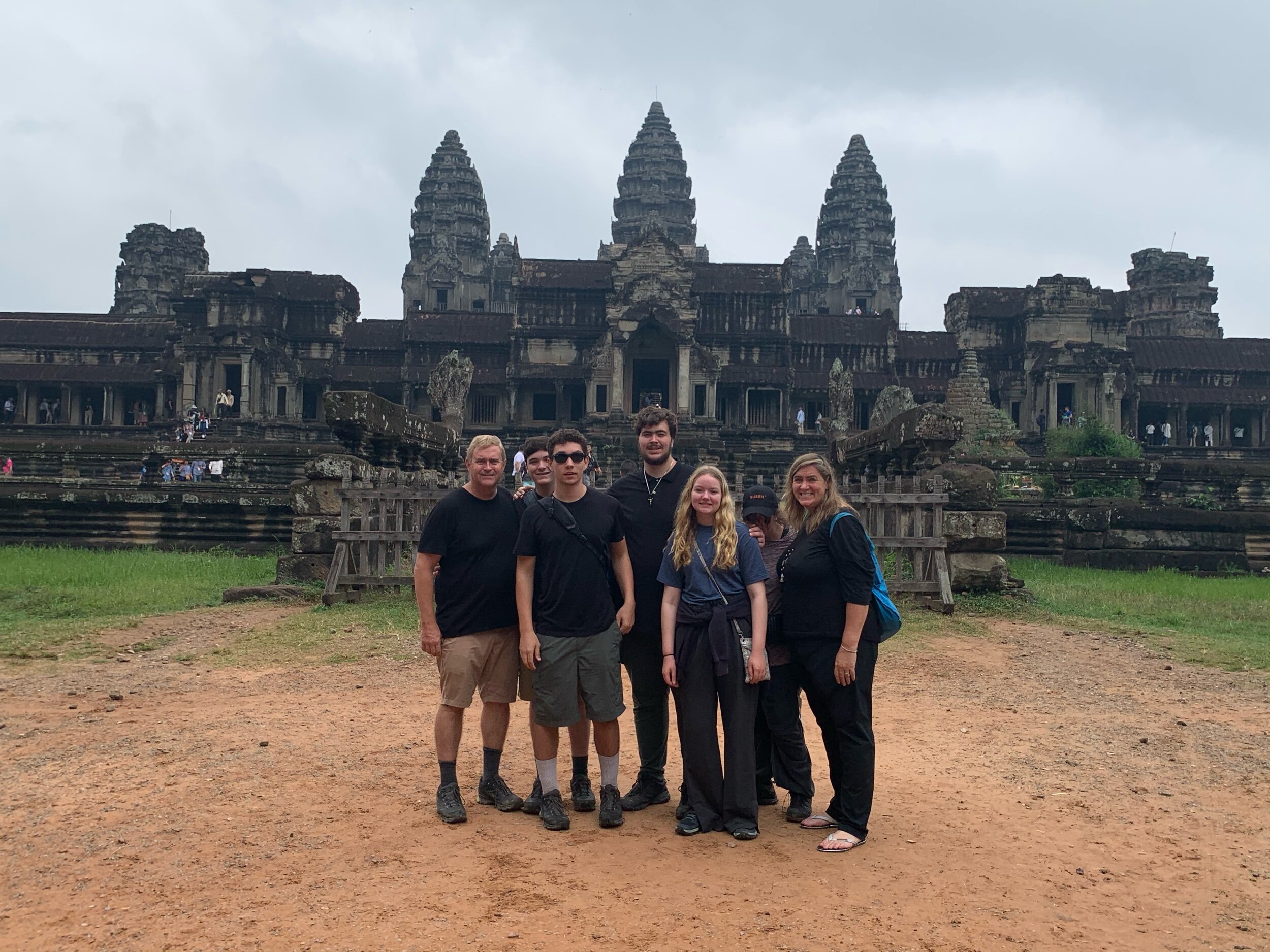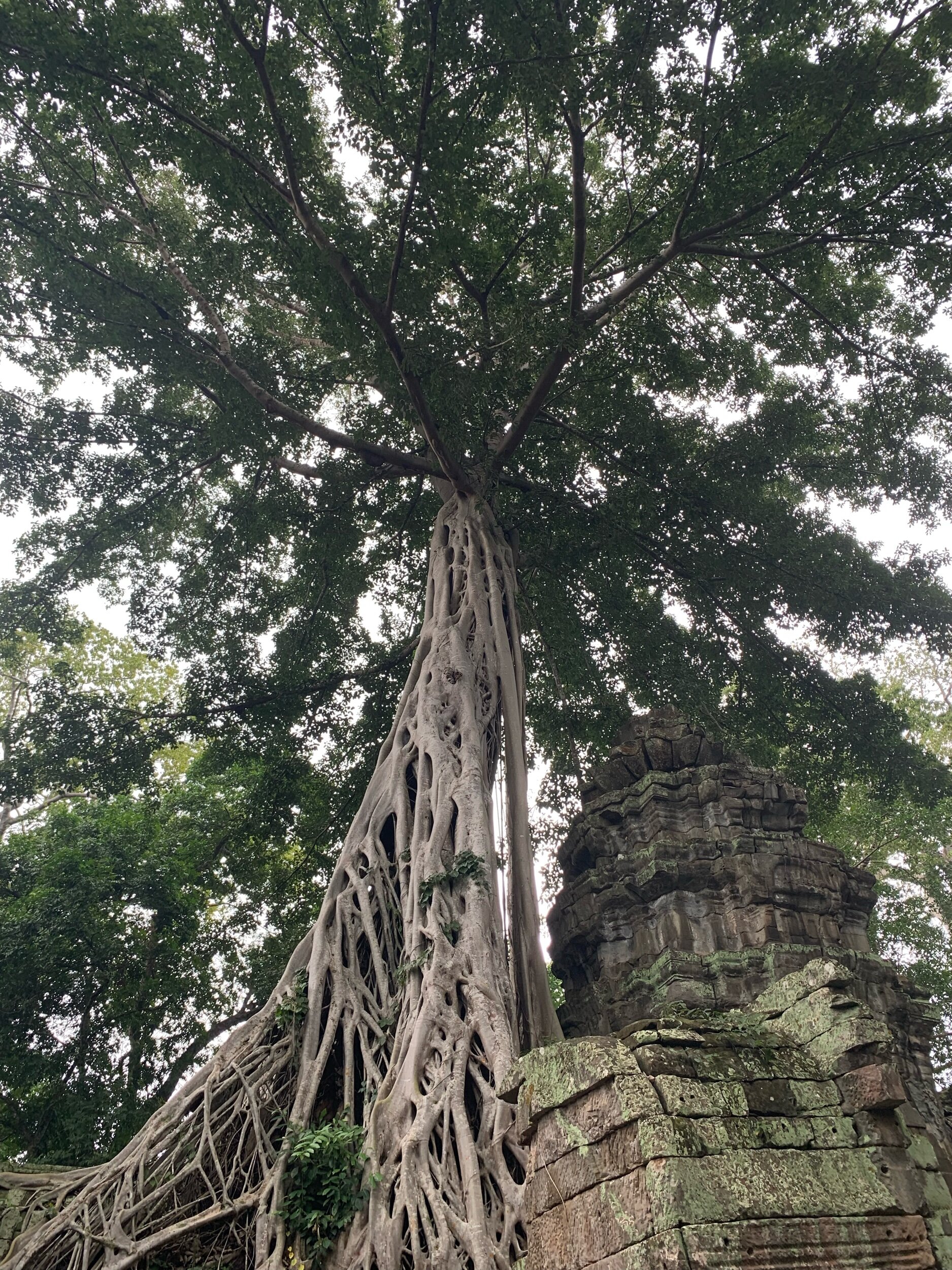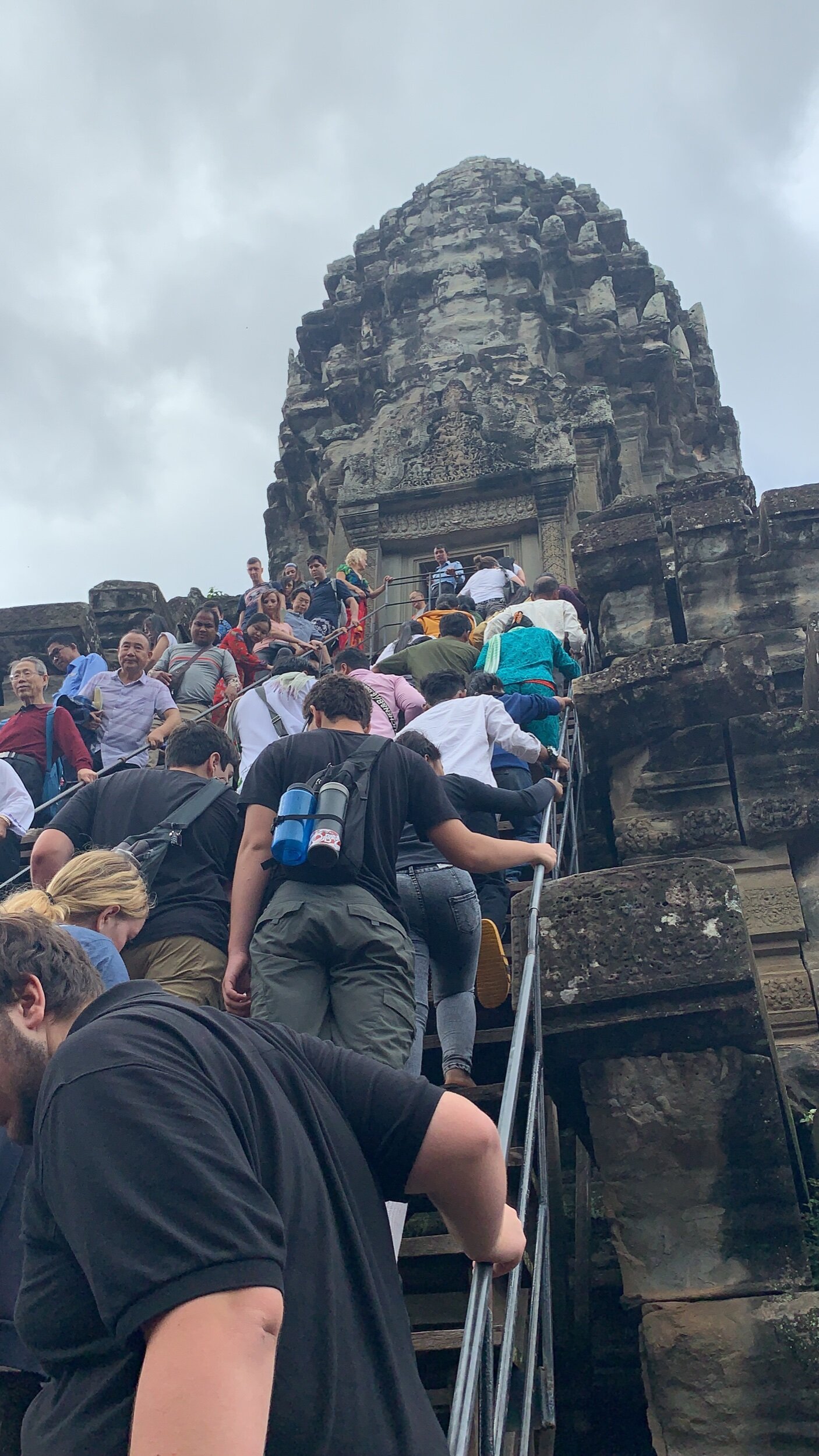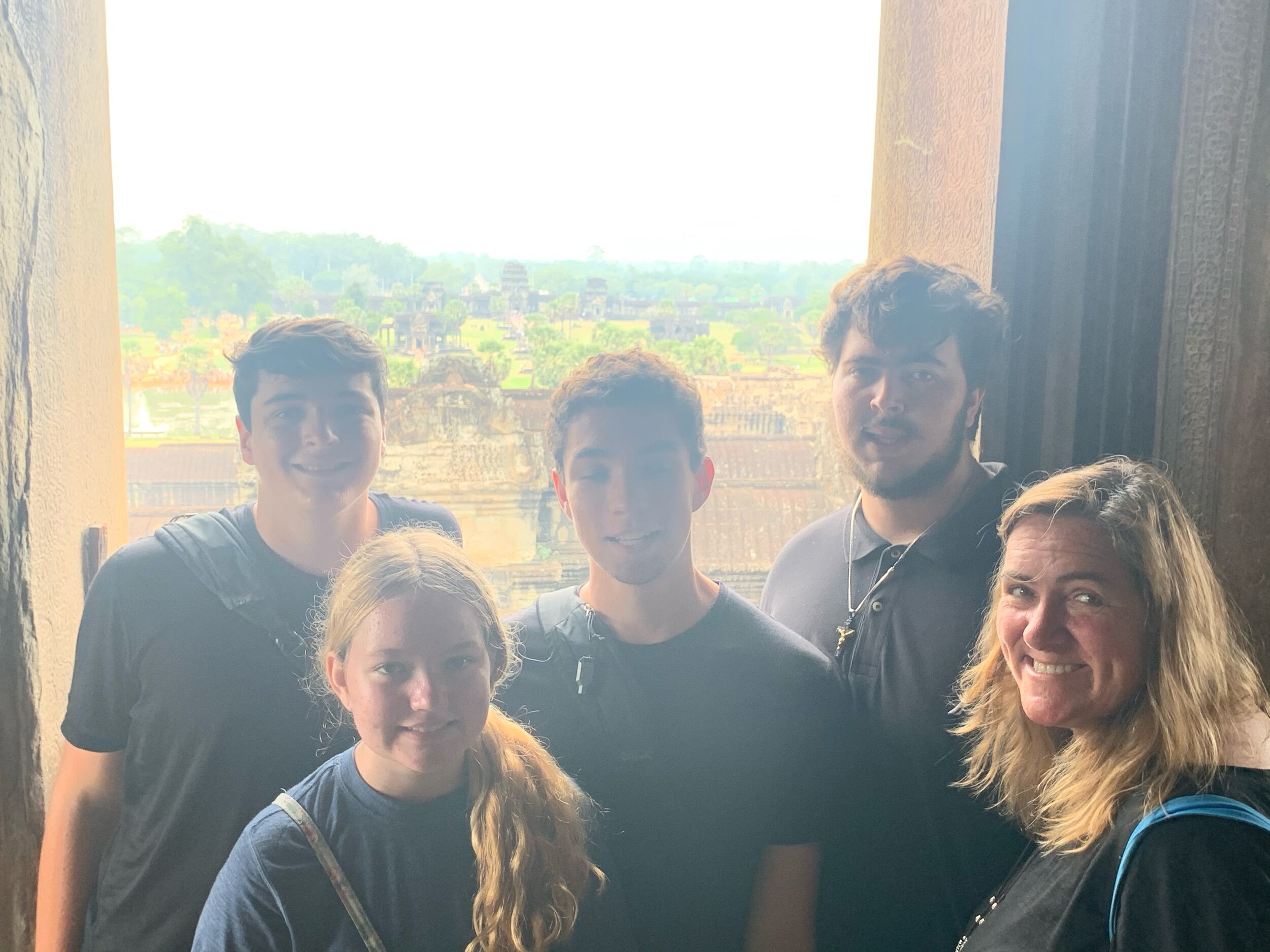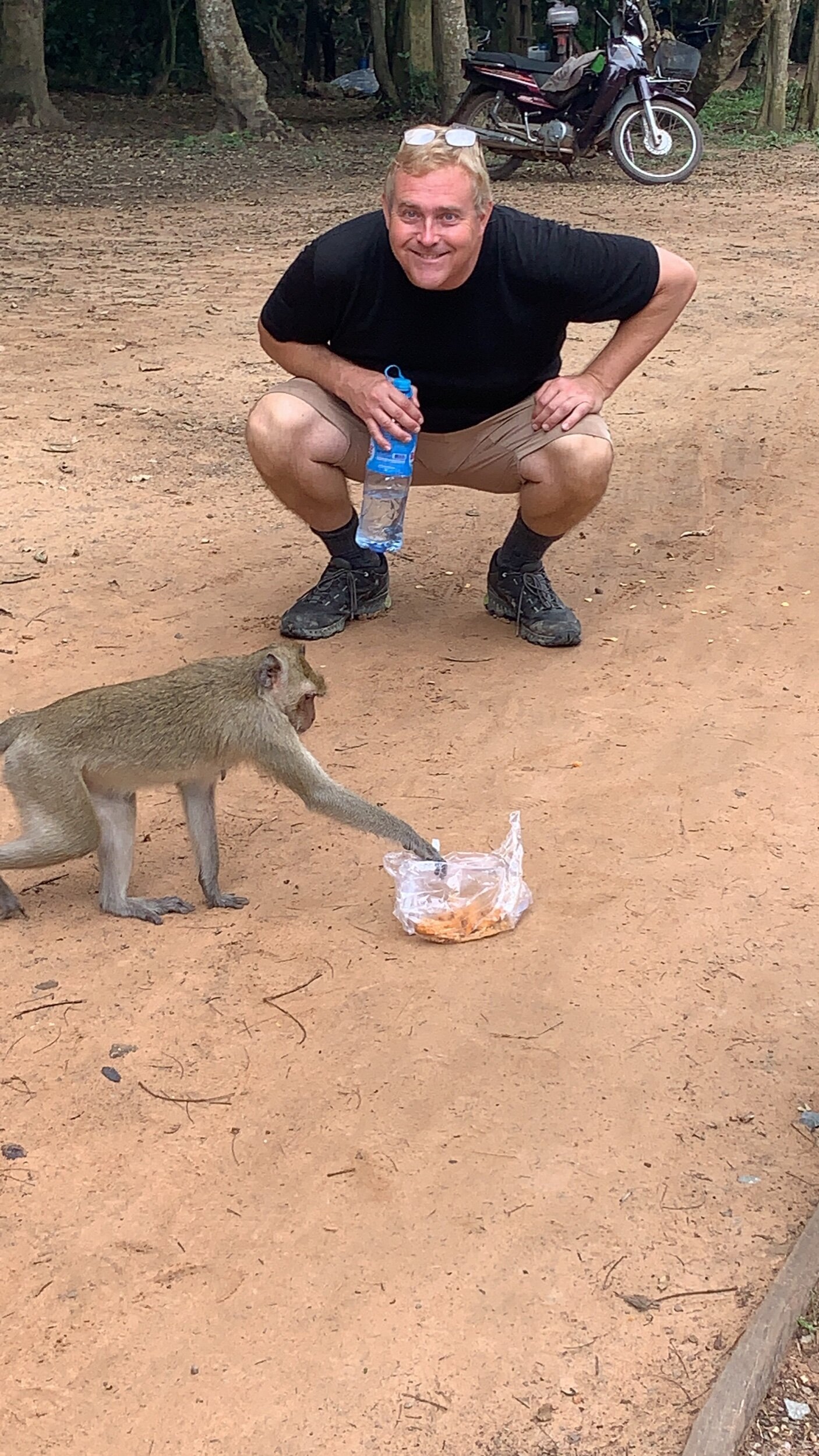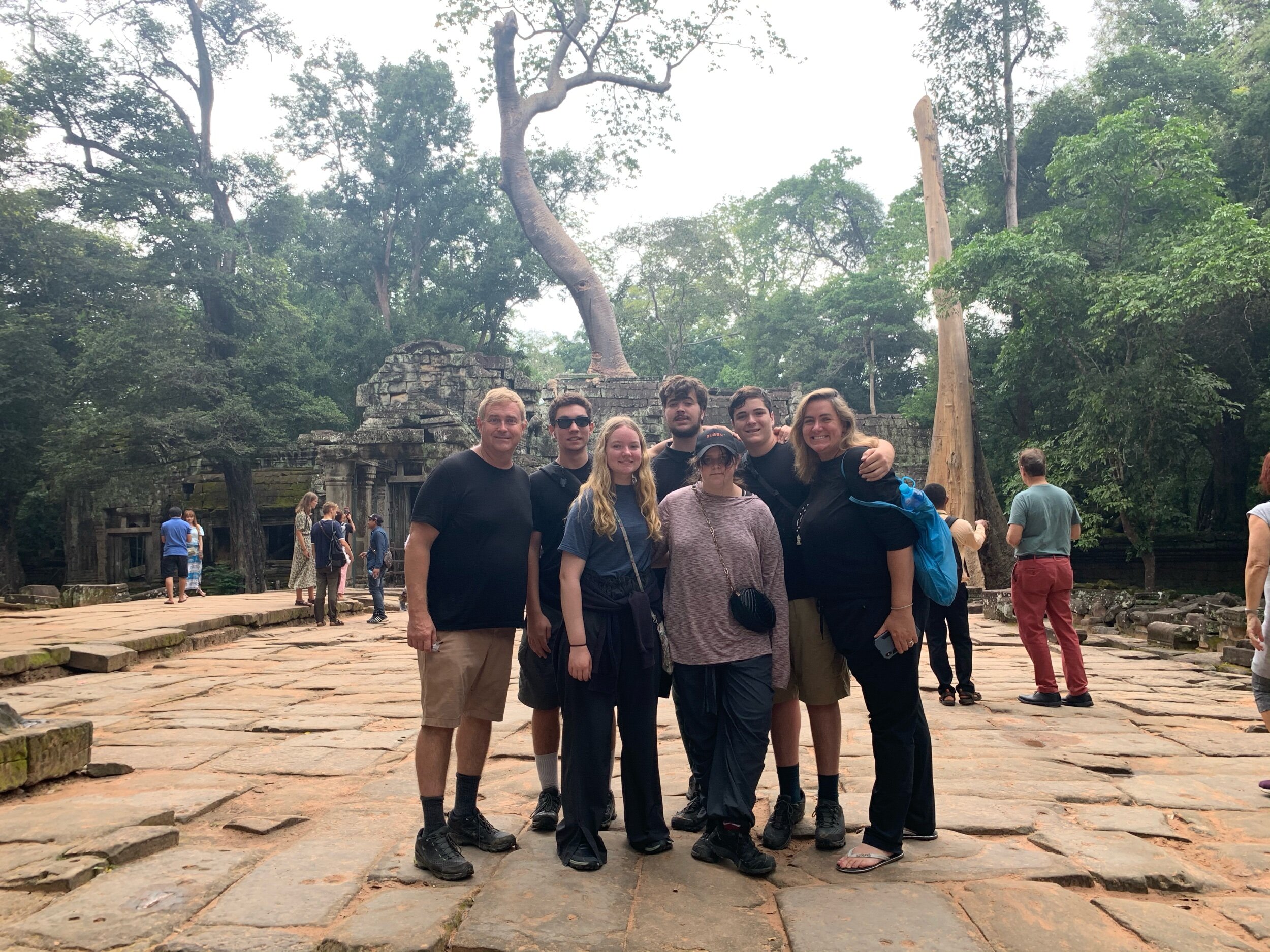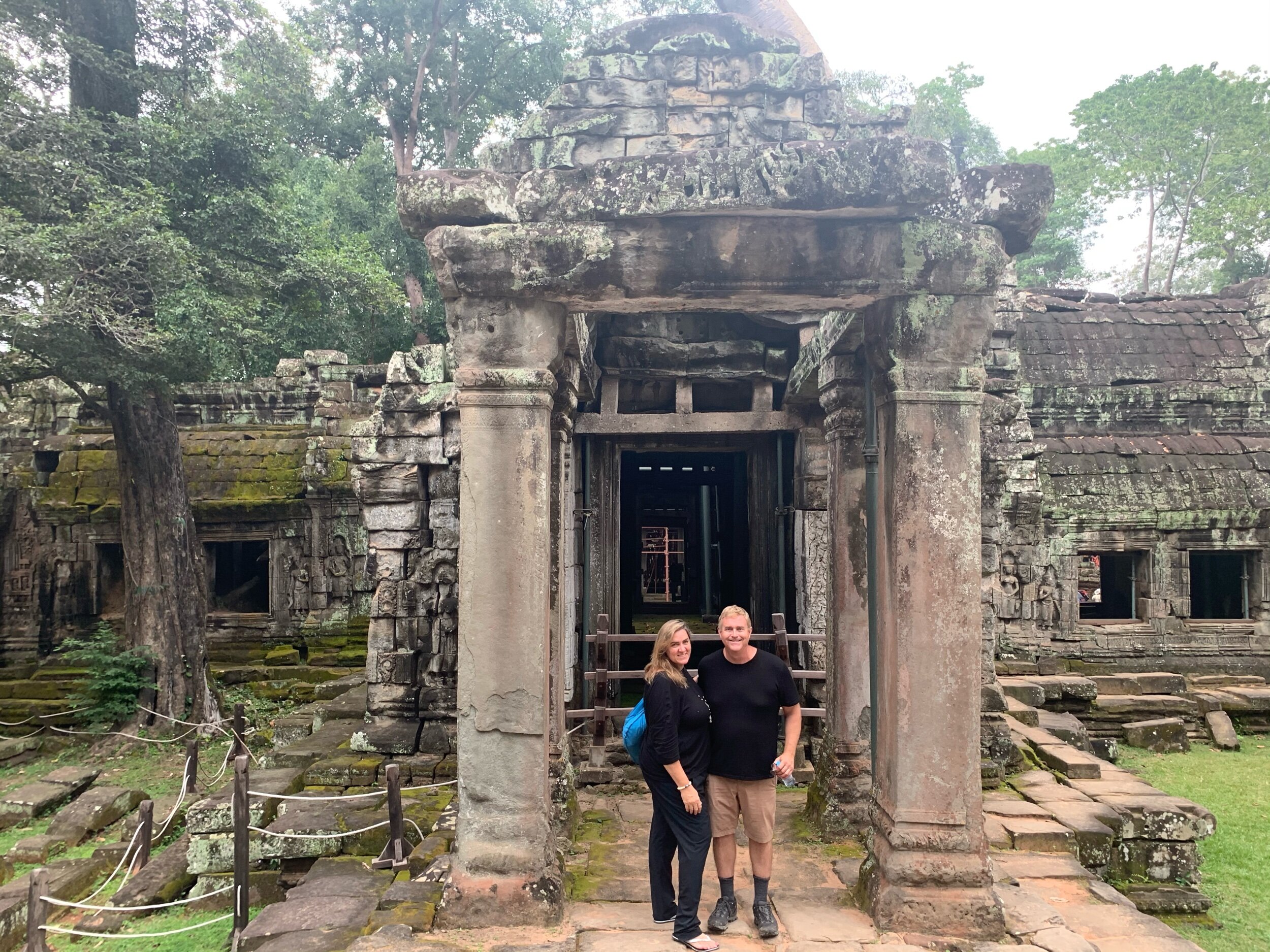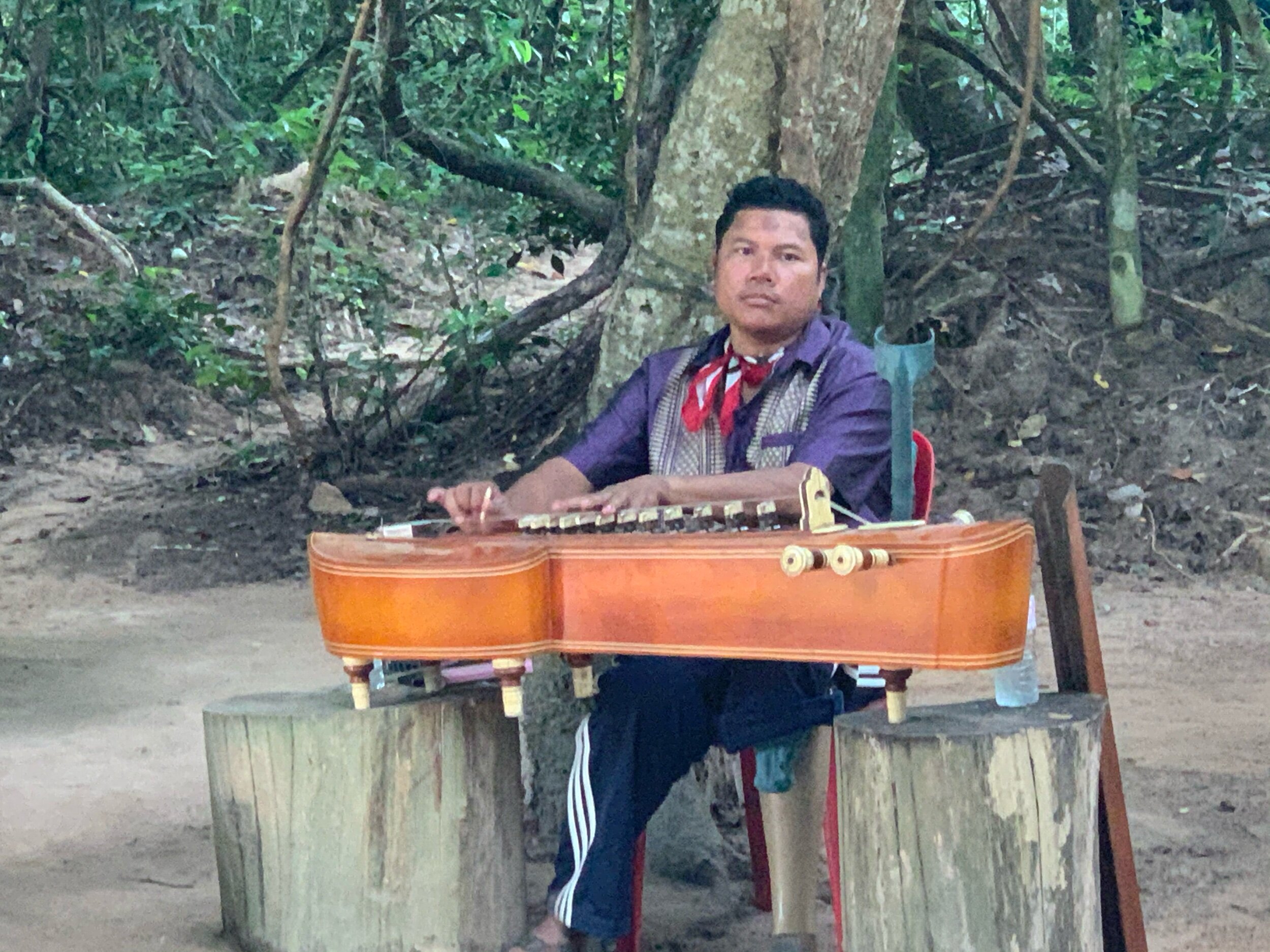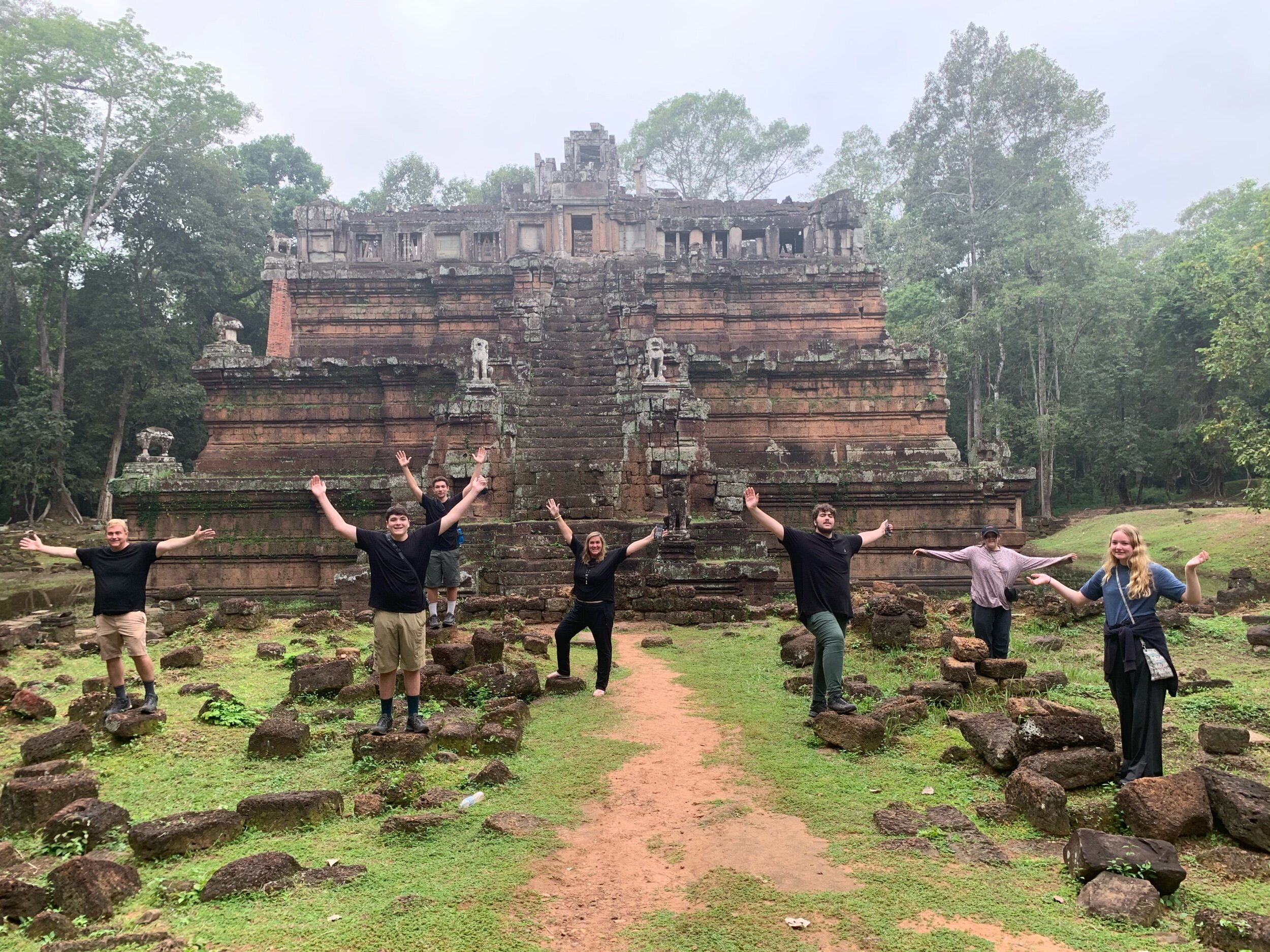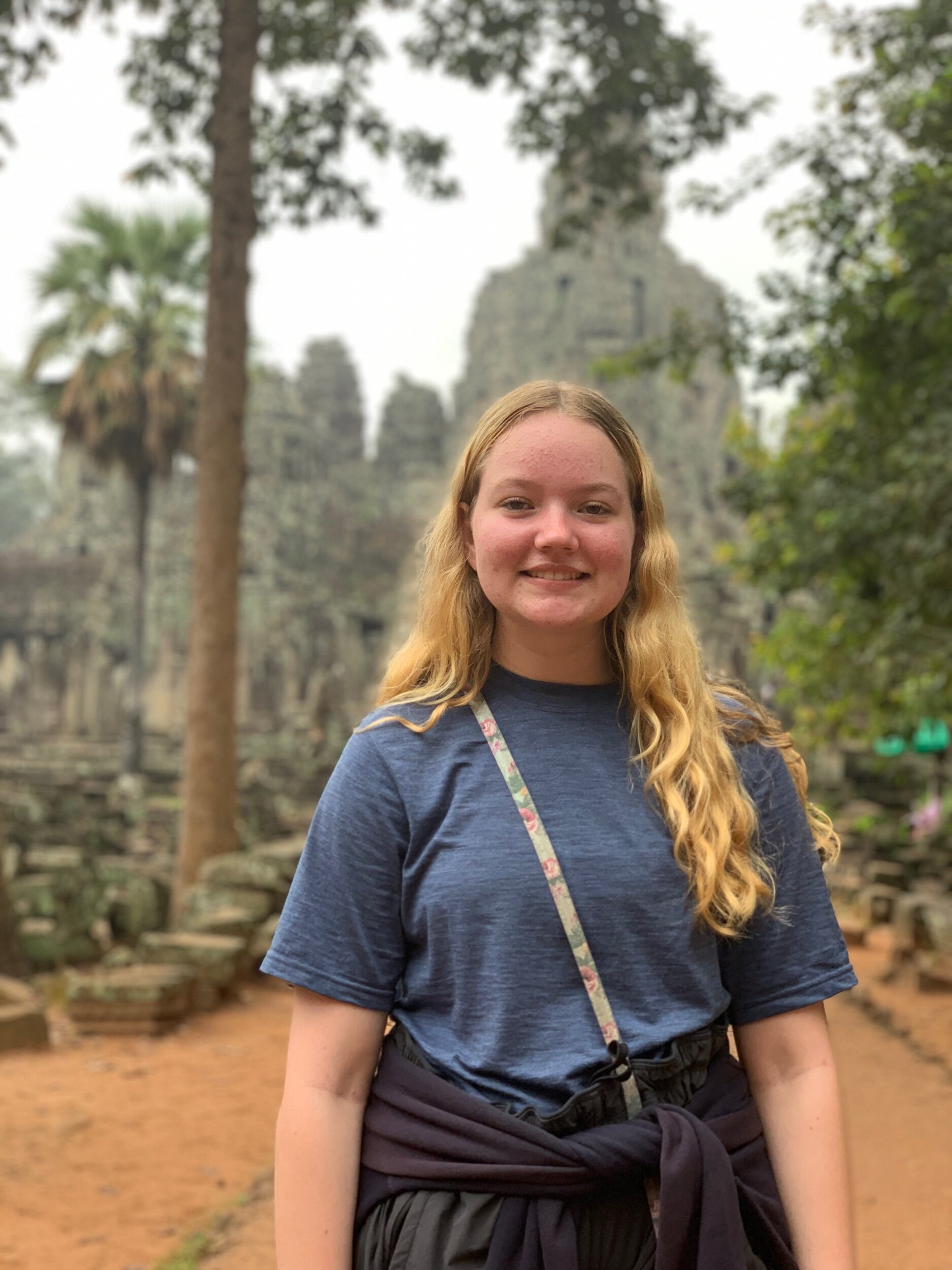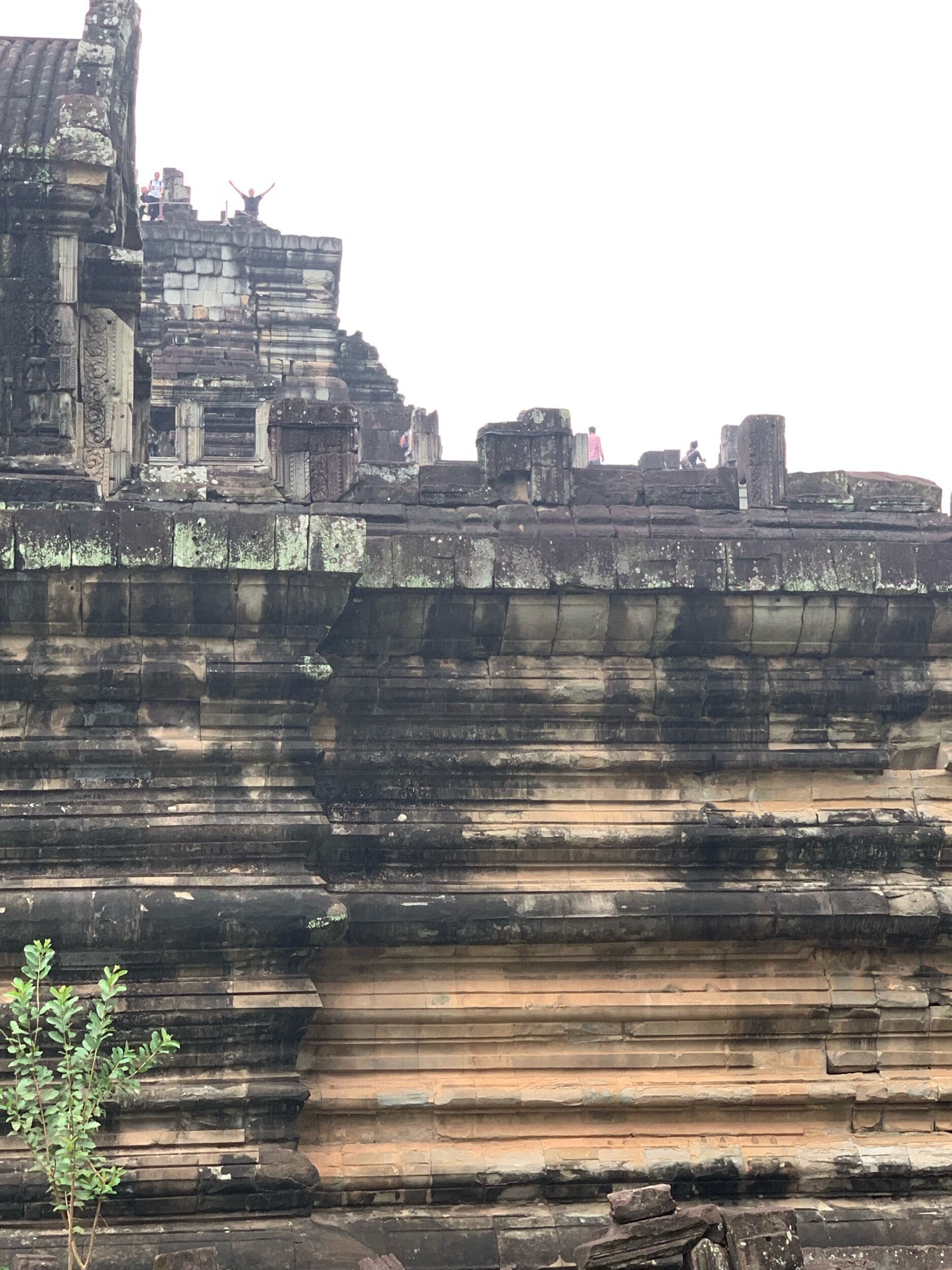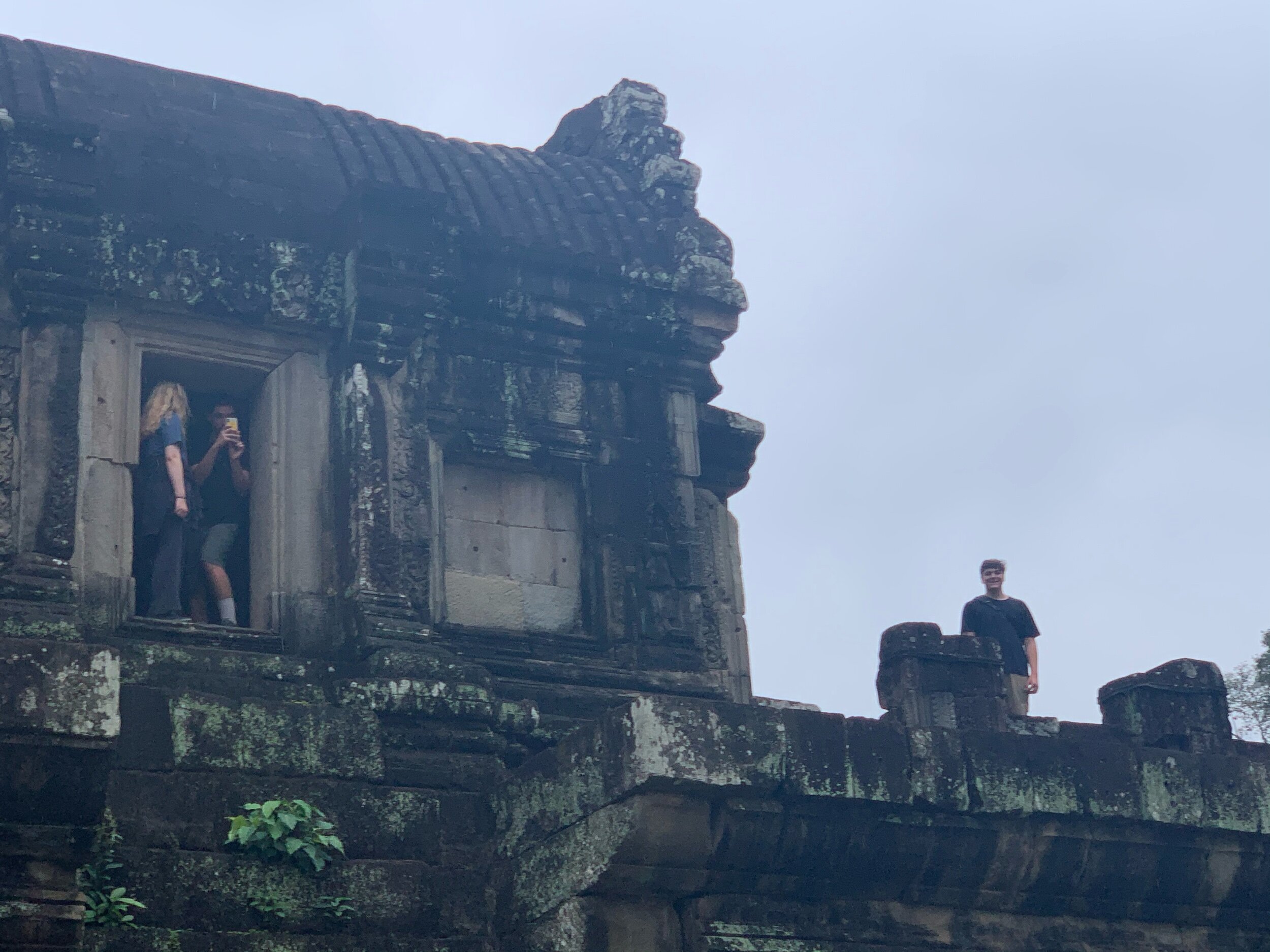11-12-19 - Angkor Wat
/Day 149. Kyle & Leanne joint blog. Siam Reap, Cambodia.
Travel day. It’s a day of what has become a now routine process of packing, hotel check-out, airport transfer, lines, check-ins, more lines, security, more lines, passport control, more lines and staid airport fast food.
Today we fly from Bagan to Mandalay to Bangkok to Siam Reap. That’s Myanmar to Cambodia via Thailand. Bangkok is like Southeast Asia’s version of the Atlanta hub. Everyone flies through there at some point and this is our third trip through Bangkok. It’s another day where we are only going a couple thousand miles but it will take all day with transport time and layovers.
The Bagan airport is so small and chill that when we check in our bags, instead of weighing them via scale, the luggage guy comes out from behind the counter picks up each of our bags, assesses its weight and says “hmmm, this one is good.” The human luggage weigher guy is a first for us. When we enter the gate area, there is an employee at a table with a printout of names and phone numbers. The check-in consists of her putting a check next to our name. We have been told by the locals that if aren’t there when boarding starts, the employee start calling people’s cell phones to ask if they need to hold the plane for them. It’s a special place for sure and we have loved the incredible hospitality shown to us here in Bagan. Top hotel chains need to send their trainees here to study service!
Even though we have three short flights today, they are on three different airlines and we have to collect our bags after each flight and check in for the next flight. We are hopeful our planes will all be on time or else a dominoes effect sets off. Lucky for us, they are. Although that doesn’t stop us from generating a couple amusing travel anecdotes.
At one security checkpoint, Ashlynn’s bag gets flagged and taken to a table. The agent tells her to take out the sharp pointy thing from her bag. Bewildered, Ashlynn tries to explain there is no sharp pointy thing. The agent remains unconvinced and starts opening pockets in search of a knife like item. After she has searched the whole backpack, she still remains unconvinced and starts taking every single item out of the bag. When you’ve been traveling for five months, a backpack can become quite the haven for miscellaneous odds and ends accumulated during traveling. 15 minutes later, there are three tubs full of stuff that have to go back through security along with the bag. The agent stands there watching the x-ray display waiting to pounce with an “I got you.” As the last tub passes through, the agent gets the crinkled eyebrow, deep in thought, perplexed look. She finally goes back to Ashlynn and tells her she can go obviously disappointed that she couldn’t tackle and cuff the knife wielding 14 year old Ashlynn. Once out of earshot, Kyle tells Ashlynn that she shouldn’t pack the phantom knife next time.
Justin has amassed quite a key chain collection from the trip resulting in a pouch with about 50 keychains. The collection is very cool except when you go through security. On most occasions, the pouch gets flagged and the agent has to dump out all the key chains and sort through them to make sure there is no weapon posing as a keychain in there. At the security checkpoint, the pouch gets flagged again. This time however; the agent starts looking through the key chain and his eyes light up. He pulls out one and yells to his fellow agent “look, look, it’s the Eiffel Tower.” Then he pulls out a Disneyland Paris one and shows his buddy. Then he pulls one out and asks Justin, “which one is this?” This goes on and on and after nearly 30 mins, the agent has identified every keychain while high-fiving his buddy when they find a particularly cool one.
As soon as we arrive in Siam Reap, Leanne has her “first 24” rule to test. A few countries ago, Leanne decided that something dramatic happens to us in the first 24 hours in every country with Vietnam taking the cake with the naked dude in the hotel hallway. So she’s on high alert monitoring for out of ordinary events. Fortunately she’s off-base for now. The hotel picked us up at the airport in their shuttle right on time and the driver Chetem even told us we hit the second night of one of their biggest festivals of the year, The Water Festival.
After a quick dinner, Leanne, Kyle and John head out to the nearby river to partake in the Water Festival. Upon arrival, we see hundreds of locals out enjoying street food, strolling the river and making flower offerings in the form of small floating lanterns on the river. Hundreds of these offerings slowly float down the river. There’s spotlights lighting up the sky and free concerts and beer gardens abound.
After finding a lively pavilion with live music, Kyle leads us up front towards the stage. The Cambodian female signer version of Taylor Swift finishes a song and the audience erupts in cheers and applause. The giant screen starts playing a commercial for a local beer, Leo Beer, featuring a Cheetah in sunglasses (Leo’s Mascot) and a guy who looks like Pitbull. Kyle and Leanne start dancing to the song “I Drink Leo” while John looks over horrified at his parent’s 1990s dance moves.
We can already tell John is trying to figure out how quickly can he eject us all from what he has now deemed as possibly unsafe situation. He’s one mature 17-year-old for sure. While we did stick out like a sore tourist thumb as we were the only non-Cambodians at the concert, it still was pretty early and looked fine from our perspective. However, we compromise with John and stay and dance for a few songs.
We retire for the evening having already fallen in love with Cambodia. And Leanne ended up finding her “something dramatic!” in the first 24 hours.
11/12 Angkor Wat.
At least two times in pre-trip planning, Angkor Wat / Cambodia was on the chopping block. Kyle had heard it was more crowded than Disney World and he was having a hard time fitting in all the countries. However; Leanne kept insisting we really need to visit there as Angkor Wat was named the number one most beautiful place to see in the world in one of the coffee table books that sat there for years in our house. Through the years of diapers, soccer games and now high school musicals, these books were gentle hints quietly inspiring our yearlong trek. Angkor Wat is so important to this country that it’s the only building that has the esteemed honor of being represented on a country’s flag. Leanne has declared Angkor Wat is a must and Kyle manages to fit it in.
Our tour guide Ra shows up at 8 am and he’s a barrel of fun at first making jokes and being jolly. As a seasoned 16-year-tenured tour guide, he’s astute at what needs to get done. He’s a 42-year old father of three, including a 10 month old and because tourism is down, he finds it harder and harder to make a living in this formerly lucrative field. He grew up on a farm but really doesn’t want to return to that profession. As the two days went on, his original upbeat happy mood turned sad as the realities of Cambodian life and tragic history weaved into his teachings.
Over the 48 hours with Ra, we heard about his crumbling marriage and his money and healthcare woes. The worse was hearing how Pol Pot and the Khmer Rouge murdered his grandfather and five uncles. By the end, we felt like we were helping with a mid-life crisis therapy session.
Back to the tour, first up is Angkor Wat which is a temple complex that is the largest religious building / monument in the world on a site measuring 402 acres. Originally constructed as a Hindu temple dedicated to the god Vishnu for the Khmer Empire, it was gradually transformed into a Buddhist temple towards the end of the 12th century. It was built by the Khmer King Suryavarman II in the early 12th century as his state temple and eventual mausoleum. Breaking from the Shaiva tradition of previous kings, Angkor Wat was instead dedicated to Vishnu. As the best-preserved temple at the site, it is the only one to have remained a significant religious center since its foundation. The temple is at the top of the high classical style of Khmer architecture. It has become a symbol of Cambodia appearing on its national flag, and it is the country's prime attraction for visitors.
Ra explains the layout of the temple complexes and how they are oriented by the elements (earth, water, fire and air) and sharing all the other symbols from Hinduism and Buddhism that impacted its impressive development way back in 1100s. We see where the king entered on his elephants, where commoners were allowed to worship, and where animals and people (to settle squabbles) would fight to their deaths.
Angkor Wat has its share of tourists but is nowhere near as crowded as Kyle had feared. The line to climb up to the upper tower was about a 20 minute wait which is the wait for the worst ride at Disneyland. It takes a while to explore Angkor Wat given its size but we are finally satisfied that we’ve left no temple stone unturned.
We walk out to explore the outer grounds of Angkor Wat. There are about twenty baby monkeys in a group going at each other in what resembles a school yard brawl. We can’t tell if the monkeys are playfully wrestling or if they’re pissed off fighting with each other. When it seems like a brawl between two of them has gone too far, the mother intervenes on behalf of her baby.
Next up is Ta Prohm Temple which is the modern name of the temple built in the Bayon style in the late 12th and early 13th centuries and was originally called Rajavihara. It was founded by the Khmer King Jayavarman VII as a Mahayana Buddhist monastery and university. Unlike most Angkorian temples, Ta Prohm is in much the same condition in which it was found. The photogenic and atmospheric combination of trees growing out of the ruins and the jungle surroundings have made it one of Angkor's most popular temples with visitors. UNESCO inscribed Ta Prohm on the World Heritage List in 1992. Today, it is one of the most visited complexes in the Angkor region.
Locals unofficially call it the Tomb Raider temple after the Angeline Jolie movie filmed at the temple. The temple was left in the original condition (unrestored) so tourists could see how the temple city of Angkor was discovered hundreds of years ago. Our guide Ra keeps talking about Angelina Jolie and Kyle notes that it appears Ra has a secret crush of her. One of the carvings in the temple looks exactly like a stegosaurus but the carving is from the late 1100’s which is well before dinosaur fossils were discovered. Coincidence or did a pre-historic stegosaurus roam the jungles of Angkor?
We grab a great local lunch on the second story of an open air restaurant enjoying fresh mango shakes and Beef Lok Lom which is one of the popular local favorites. After lunch, we head to Angkor Thom which King Jayavarman VII built in an attempt to outdo all of his predecessors’ temples. Unlike Angkor Wat, which is a one huge temple, Angkor Thom is sprawling complex of temples, fields and waterways.
Angkor Thom which translates to "Great City" was the last and most enduring capital city of the Khmer empire. It was established in the late twelfth century by King Jayavarman VII. It covers an area of 9 km², within which are located several monuments from earlier eras as well as those established by Jayavarman and his successors. At the center of the city is Jayavarman's state temple, the Bayon, with the other major sites clustered around the Victory Square immediately to the north.
Jayavarman VII (1122-1218) was a king of the Khmer Empire who reigned from 1181–1218. He married Princess Jayarajadevi and then, after her death, married her sister Indradevi. The two women are commonly thought to have been a great inspiration to him, particularly in his unusual devotion to Buddhism, as only one prior Khmer king was a Buddhist. He then built the Bayon as a monument to Buddhism. Jayavarman VII is generally considered the most powerful of the Khmer monarchs by historians.
Within Angkor Thom, we come first to the Terrace of the Elephants which are effectively two huge fields which were used for entertainment and sports. Next we come to Phimeanakas Temple which is more of a photo stop as we are not allowed inside.
We then hit The Baphuon temple, built in the mid-11th century and is a three-tiered temple mountain dedicated to the Hindu God Shiva. It has intricate carvings covering every available surface. The temple stands 34 meters tall without its tower, which would have made it roughly 50 meters tall. In the late 15th century, the Baphuon was converted to a Buddhist temple. A 9 meter tall by 70 meter long statue of a reclining Buddha was built on the west side's second level, which probably required the demolition of the 8 meter tower above to supply stones for the statue, thus explaining its current absence.
We climb a ton of stairs to get to the very top. Kyle is taking pictures with the kids when he notices two twenty-something year old girls taking a selfie out on the ledge. Kyle tells the kids “remember kids, no selfies on cliffs.” The girls burst out laughing until they realize Kyle was referring to them and they quickly scamper off the ledge back to safety.
Our last stop within Angkor Thom is Bayon Temple which was built in the late 12th Century and is the grandest and most well-known temple of Angkor Thom. The Bayon is a richly decorated Khmer temple built state temple of the Mahayana Buddhist King Jayavarman VII. Following Jayavarman's death, it was modified and augmented by later Hindu and Theravada Buddhist kings in accordance with their own religious preferences. The Bayon's most distinctive feature is the multitude of serene and smiling stone faces on the many towers which jut out from the upper terrace and cluster around its central peak. Our guide Ra informs us that the faces are believed to be that of King Jayavarman VII. With a total of 216 stone faces, the King ensured that he had the Buddha statutes and images outnumbered about five to one at this temple.
We have dinner at the hotel and retire early as we have another full day of exploring Angkor tomorrow.










